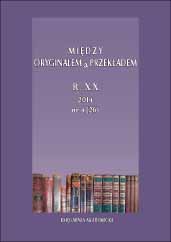Translatorskie losy pieśni Horacego „Ad Lydiam meretricem”
Horace’s ode III 9 and its interpretations
Author(s): Agata ŁukaSubject(s): Language and Literature Studies
Published by: KSIĘGARNIA AKADEMICKA Sp. z o.o.
Keywords: Horace; Sarbiewski; Radnóti; Carmina III 9 (“Donec gratus”); the Second Asclepiadean (according to the most accessible English editions)
Summary/Abstract: The role of Horace in the history of European literature is obvious and tremendous, his works were paraphrased and translated by many authors (e.g. by B. Jonson, H. Tournier, J.H. Voss, E. Mörike, Fr. Gehlen, E. Geibel, M. Radnóti, and in Poland by L.H. Morstin, T.F. Hahn, S. Gołębiowski, A. Lam). His carmen “Ad Lydiam” (Carmina III 9) is Horace’s only ode composed as a dialogue. Translations of this ode are numerous and various, usually rhymed or rhythmic, occasionally isometric. Among the authors of the latter ones German translators excel; German as a language of quantity is ideal to show Horace’s metrical pattern both by keeping a fixed number of syllables (8 in every odd, 12 in every even verse) and the arrangement of stressed and unstressed elements. There are no Polish isometric translations of ode III 9, as they usually sound unnaturally or even oddly (from the 16th century onward Polish is not a language of quantity any more). In recent years excellent isometric translations of odes composed in the Second Asclepiadean were written by E. Buszewicz (Horacy, Carm. I 13; Sarbiewski, Lyr. I 19 and III 2). Isometric translation of Horace’s ode III 9 by a Hungarian poet Moklós Radnóti was in turn used by Ferenc Sebő as the lyrics of a song entitled “Lydiához”. The music of the song was then used by the Polish band Brathanki, although lyrics by Z. Książek do not refer to Horace’s Latin original. There is, however, something interesting about it: because of the fact, that the lyrics were written for already composed music, the vocalists of the band unknowingly sing the rythm of the ancient Second Asclepiadean II. The author of a paper presents her own isometric translation of carmen “Ad Lydiam” into Polish.
Journal: Między Oryginałem a Przekładem
- Issue Year: 2014
- Issue No: 26
- Page Range: 79-100
- Page Count: 22

